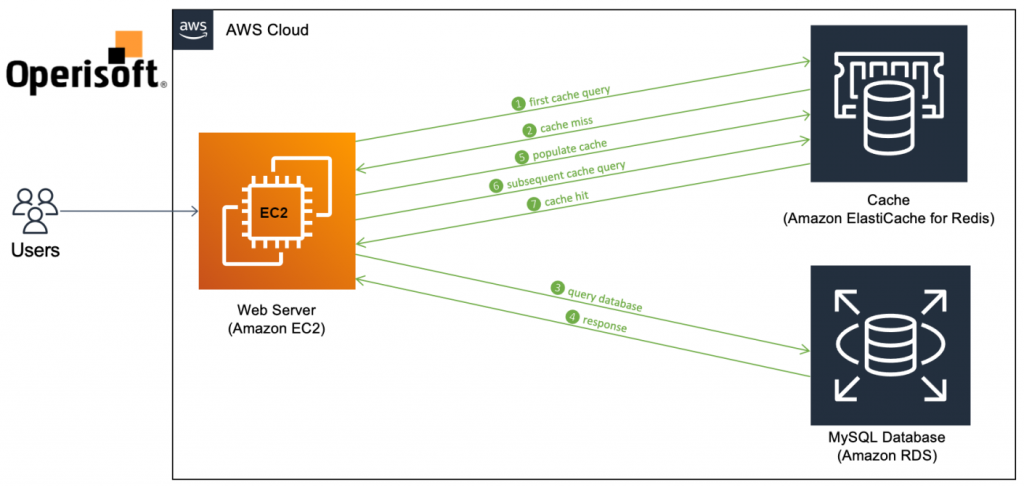In today’s fast-paced digital world, performance optimization is very crucial for delivering exceptional user experiences. Amazon ElastiCache is a fully managed memory caching service that offers powerful capabilities to accelerate the performance and scalability of your applications.
By implementing effective caching strategies with ElastiCache, you can reduce the load on your backend systems, minimize response times, and enhance the overall user experience.
The Elasticache service of aws provides two open-source service caching engines. Memcached and Redis, the Memcache provides a high performance and scalable caching solution. making it ideal for use cases that require fast access to key-value data.
While the Redis offers advanced features such as data replication, data structures and persistence, making it a versatile caching engine suitable for a wide range of use cases.

Fig 1.1: – working of the Elasticache service.
The diagram depicted above illustrates the functionality of the Elasticache service, with the arrows representing its operational mechanism.
Features of Elasticache service
Performance Gains: it stores frequently requested data in memory, lowering the latency associated with obtaining data from databases or backend services dramatically. As a result, applications run better and respond more quickly.
Scalability: The ElastiCache is designed to scale seamlessly with your application’s growing demands. You can easily add or remove cache nodes to handle increased traffic and accommodate changing workloads, ensuring optimal performance and scalability.
Cost reduction: it assists in optimising resource use and lowering infrastructure costs by relieving the load from backend systems and databases. Your application’s total operational expenses will go down if you cache frequently used data. This cuts down on the requirement for pricey data retrievals.
Compliance and security: ElastiCache provide strong security safeguards for protecting your cached data. It enables encryption both in transit and at rest, allowing you to protect sensitive data. ElastiCache also provides authorization and authentication features to guarantee that only authorised people or programmes may access the cache.
Data durability: it also supports data durability, means it help you to store and retrieve data even if a cache node fails or restarts, it reduces the possibility of data loss and guarantee the durability of your data storage.
Fully Managed: it is a fully managed service, taking care of infrastructure provisioning, software patching, and backups. This relieves you from the operational burden of managing caching infrastructure.
Caching Strategies for the application.
There are several different caching strategies that you can use with Amazon ElastiCache. The best strategy for your application will depend on the specific needs of your application, let us explore some caching strategies that can help optimize performance with Amazon ElastiCache.
- Object-level caching
- Query caching
- Result set caching
- Page-level caching
- Session caching
- multi-level caching
- Cache pre-warming
Object-level caching: It is a powerful caching strategy that optimizes application performance by storing specific data objects or entities in the cache and instead of fetching the data from back end systems or databases repeatedly, subsequent requests can be served directly from the cache.
This approach significantly reduces the latency typically associated with data retrieval, resulting in enhanced application performance.
By leveraging object-level caching, you can minimize the time and resources required to retrieve frequently accessed data, leading to faster response times and a more efficient application.
Query caching: The query caching works for the application that execute repetitive queries with similar parameters, caching this query result in the Elasti cache is a powerful technique.
by storing the result in cache, the subsequent or the repetitive request can be directly served from this cache, eliminating the need to query the database each time. With this approach of query caching, it reduces latency, decreases database load, and boosts overall performance of the application.
Result set caching: Utilizing the result set caching in Elasticache can greatly enhance application performance. By caching the entire result set, you eliminate the need to retrieve the data from the database for each request.
Instead, you can serve the results directly from the cache, leading to significant reductions in response times. Result set caching proves especially advantageous for read-heavy applications where the result sets remain mostly unchanged over a specific duration.
Implementing this caching strategy allows for faster data access, improved efficiency, and a smoother user experience of the application.
Session Caching: Applications with large user bases that relies heavily on session management can benefit from caching session data in ElastiCache. The stress on session stores or databases can be reduced by storing session data in a quick and scalable cache.
When session data is accessed from the cache, speedy retrieval is ensured, application responsiveness is enhanced, and resources are freed up for other crucial tasks. Effective session expiration and update management requires the implementation of proper cache eviction techniques.
Page-Level Caching: comes in for the application that contain static or semi-static content which doesn’t changes frequently. Implementing the page-level caching in the elasticache can provide impressive performance gains.
By storing the rendered HTML pages or the dynamic pages in the cache This approach improves response times, reduces load on server, and enhances scalability, leading to an overall smoother user experience.
Multi-level caching: A caching strategy that uses multiple levels of cache to store data. This can improve performance by reducing the number of times data needs to be retrieved from a slower source, such as a database.
When a user requests data, the application first checks the first level cache. If the data is in the first level cache, it is returned to the user. If the data is not in the first level cache, the application checks the second level cache. If the data is in the second level cache, it is returned to the user.
If the data is not in the second level cache, the application checks the third level cache. If the data is in the third level cache, it is returned to the user. If the data is not in any of the caches, it is retrieved from the database and added to the first level cache so by that it can speed up the response.
Cache pre-warming: It is a proactive technique which optimize the performance of the application by populating the cache with frequently accessed data ahead of traffic.
with essential data, cache pre-warming ensures that subsequent user requests can be served directly from this cache, minimizing the need to fetch data from backend system or database.
Conclusion:
Optimizing performance with Amazon ElastiCache is essential for achieving a seamless user experience and effective scalability of your applications.
By employing a range of caching techniques such as object-level caching, query caching, result set caching, page-level caching, session caching, and multi-level caching, you can significantly improve the performance and scalability of your applications.
These caching strategies enable faster data retrieval, reduced latency, and efficient resource utilization, ensuring a smooth user experience and accommodating the growing demands of your application.
By leveraging the power of ElastiCache’s caching capabilities, you can enhance the overall performance and scalability of your applications on the AWS platform.







